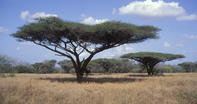
Name
Umbrella Thorn (Acacia tortilis)Description
This tree is the archetypal shape of a thorn tree, shaped like an umbrella. It is a slow growing tree, reaching heights from 5 m to 20 m and a span of 8 m to 13 m. The bark is greyish-black in colour and is rough to the touch. Its thin, white thorns grow in pairs of one straight and one hooked thorn, and its leaves are small giving the tree a soft appearance.
The umbrella thorn tree blooms in December, carrying thick, creamy white spheres of florets, which form in bunches on older wood. Its pods are curly and a light gold-brown in colour.
Flowering can be sporadic, however, depending on the rains. Many animals depend on the umbrella thorn tree for food and shelter. Various bird species nest under their wide canopies, and animals browse on their leaves and thorns when soft and new. Its thorns harden with age, preventing over-browsing.
Umbrella Thorn Flowers and Fruit
The pods of the umbrella thorn tree are eaten by wild and domestic animals as well as humans, at times. These twisty, gold-brown pods fall to the ground unopened in large quantities. Animals such as the kudu, impala, rhino and elephant enjoy feeding on the pods, distributing its seeds through their dung. Sometimes the pods open before falling to the ground, scattering their seeds from the tree.Umbrella Thorn Uses
The wood of the umbrella tree is used for wagon wheels, furniture, firewood and fence posts. Its branches are sometimes used to make temporary pens and cages. The tree is planted in Africa and India as a method of reclaiming dunes. Its bark is used to make string in Tanzania, and apparently a good source of tannins.
The tree gum is edible and chewed as a poor man’s gum. In some parts of Africa the pods were once strung as necklaces, and the bendy roots were used by nomads as frameworks for temporary shelters. The Senegalese also used the roots for spear shafts, and people from Lake Chad used it as stems for fish spears.
The pods of the umbrella tree contain many nutrients and is browsed by game and livestock. Baboons, vervet monkeys and other animals eat the new green pods which have fallen to the ground. The dried pods make good fodder for grazers in the desert. As its leaves are also fed on, the umbrella tree is one of the prominent dry season fodder trees in the Sahara-Sahelian region.